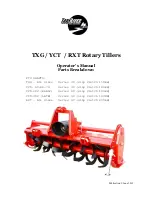
10
ARTC-SVX002A-EN
Pre-Installation
Preparation for Initial Startup
After the system is completely installed with all wires
connected and all piping securely coupled, the chiller can
be prepared for initial startup.
Ensure there is a sufficient cooling load available for
proper testing of the chiller system.
Initial Startup
1. Close all drain valves and header purge valves.
2. Fill the chiller with clean water/glycol mixture.
3. Inspect all connections for leaks during the filling
process.
4. De-energize chiller using industry-standard lockout/
tagout procedures. Verify main power is turned off at
the power distribution panel. Validate de-energization
using voltage meter.
5. Inspect all electrical connections to ensure terminals
are secure.
6. Inspect all fuses and overload settings to ensure they
conform to specifications.
7. Inspect all refrigerant pressures for each module to
ensure no refrigerant has been lost.
8. Check that pressure switches and thermostats have
correct “cut-in” and “cut-out” settings.
9. Confirm the oil level is correct in each compressor.
Note:
If Trane pumps are provided, check that each
pump’s overload setting matches the
nameplate amperage of the pumps as
described previously. “Bump” pump motors
on to verify correct rotation.
10. Connect phase monitor wiring, if required.
11. Connect remote flow switch if the chiller is so
equipped.
12. Ensure refrigerant valves are open at the compressors.
13. Confirm that pressure and temperature switches are in
the closed position.
14. Apply power to all modules in the chiller.
15. Turn on the condenser and evaporator fluid pumps and
ensure there is proper flow and the pressure drop
across the system is as expected.
16. Monitor and record all temperatures and refrigerant
pressures.
WARNING
Hazardous Voltage!
Failure to disconnect power before servicing could
result in death or serious injury.
Disconnect all electric power, including remote
disconnects before servicing. Follow proper lockout/
tagout procedures to ensure the power can not be
inadvertently energized. Verify that no power is present
with a voltmeter.
NOTICE
Compressor Failure!
Failure to follow instructions below could result in
catastrophic compressor failure. Do not operate with
insufficient oil.











































